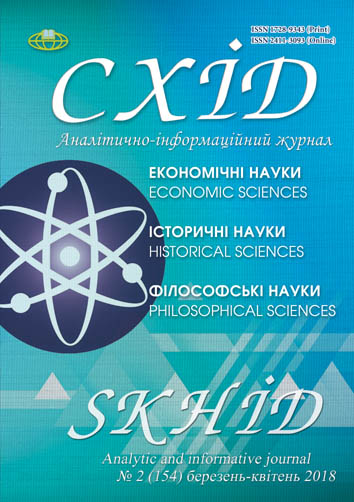National army of Pavlo Skoropadskyi as conception and reality (April-December 1918)
DOI:
https://doi.org/10.21847/1728-9343.2018.2(154).132969Keywords:
Hetman Pavlo Skoropadskyi, Ukraine, Armed Forces, military education, Military Manual of Hetmanate timesAbstract
This year is marked with a centenary of governance of Hetman Pavlo Skoropadskyi, one of the most charismatic leaders of the Ukrainian state over the period of national liberation struggle of the Ukrainian nation in the 20th century (29.04 - 14.12.1918). The formation of the Armed Forces of the Ukrainian state is considered probably the greatest achievement of the Hetman as he managed to involve in the above process some experts who were highly qualified and willing to serve Ukraine though it was not easy, given the fact that most Ukrainian public figures preferred to cooperate with Bolsheviks rather than the 'reactionary pro-Russian' government.
The article reviews the formation process of military forces of the Ukrainian state during the above period. It is shown that over a short governance period Hetman and his public officers managed to create an efficient army numbering about 65 thousand people. The presentation logic covers the army formation by branches of troops, which enabled the author to outline an army structure. It is pointed out that P. Skoropadskyi's idea was to use Ukrainian Cossacks as an important mobilization factor for a future national army. In October 1918 he issued a Universal on revival of the Ukrainian Cossacks in eight provinces of Ukraine, under which the above institution was to be in charge of physical and moral education of youth, life arrangement of military community as well as cultural and educational activities in the army.
Rights and obligations of military personnel, the term of service and potentiality of engaging the military in social life were regulated by the following laws issued during the Hetmanate period: "On General Military Service Duty" and "On Political and Legal Situation of Military Servicemen".
It is also established what training background was created over the period under review to support and develop the Ukrainian Armed Forces.
References
Verstyuk, V., 1995. The Ukrainian Revolution: The Day of the Central Council. Ukrainian Historical Journal. No. 6, p.77 (ukr).
Pyrig, R. (comp.) and others, 2015. Ukrainian state (April-December 1918). Documents and materials. In two volumes, three parts. P.2. Tempora, Kyiv, XXX + 412 pp. (ukr)
Tkachuk, P.P., 2009. Land forces of Ukraine during the revolution of 1917-1920. LIVS, Lviv. 312 p. (ukr).
Gyrych, Igor (comp.), 2016. Skoropadsky P. P. Memoirs: end of 1917 - December 1918. Nash format Publishing, Kyiv, 480 p. (ukr).
Lytvyn, M. and Naumenko, K., 2007. Armed Forces ofUkraineof the 20th Century. Generals and Admirals. Kharkiv-Lviv, рр. 3, 217 (ukr).
Tynchenko, Y., 2012. Naval Forces of Ukraine. 1917-1921. Tempora, Kyiv: 27-52 (ukr).
Doroshenko, D., 2003. History of Ukraine1917-1923. T.ІІ: Ukrainian Hetman’s State of 1918. W.p., Kyiv: 146-147 (ukr).
Morgun, M.V., 2011. Organization and combat use of armored units of Ukrainian armies in 1917-1920. Candidate of Historical Sciences, Abatract. Lviv, 19 p. (ukr).
Tkachuk, P.P., 2009. Land forces of Ukraine during the revolution of 1917-1921. Lviv: LISV, 329 p. (ukr).
Zadunayskiy, V., 2003. Influence of Cossack military traditions on creation of the Armed Forces of the Ukrainian state Hetman P. Skoropadsky. In: P. Dobrov (Editor-in-Chief). Historical and political studies. Donetsk. 98-104 (ukr).
Derzhavnyy vistnyk. 1918. № 9. June 2; No. 59. October 16 (ukr).
Haruk, A.I., 2000. Air Force of Ukraine in 1917-1920. Candidate of Historical Sciences. Lviv, 180 p. (ukr).
Haruk, A.I., 2011. Aircraft industry of Ukraine as a component of the military-industrial complex in the 1910s - 1980s. Doctor of Historical Sciences. Lviv, 379 p. (ukr).
Khoma, I., 2016. History of the Military Formation of the Sich Riflemen (1917-1919). Publishing House of Lviv Polytechnic, Lviv, 240 p. (ukr).
Krezub, A., 1928. Revolt against Hetman Skoropadsky and Sich arrow. Literary and scientific herald. Vol. 97, Kn.12. Lviv, p. 309 (ukr).
Kryvyzyuk, L.P., 2006. Armed Forces of Ukraine 1917-1920: schooling and upbringing. Lviv Military Institute, Lviv Polytechnic National University, Lviv, 254 p. (ukr).
Yakimovich, B., 1996. Armed Forces of Ukraine. Essays on history. Lviv, 359 p. (ukr).
Derzhavnyy vistnyk. 1918. № 69. November 2 (ukr).
Governments of the Ukrainian State - History. Government portal. URL: http://old.kmu.gov.ua/kmu/control/uk/publish/article?art_id=661535&cat_id=661211 (Accessed: 2017, December 12).
Baranovska, N. M., 2014. The foundations of military policy of Hetman Pavlo Skoropadsky. Bulletin of the Lviv Polytechnic National University. State and Army. No. 784, pp. 90-97. URL: http://nbuv.gov.ua/UJRN/VNULPDA_2014_784_16 (Accessed: 2017, December 12).
Downloads
Published
How to Cite
Issue
Section
License
Copyright (c) 2018 Bogdan Levyk

This work is licensed under a Creative Commons Attribution-NonCommercial-NoDerivatives 4.0 International License.
1. Authors bear responsibility for the accuracy of facts, quotations, numbers and names used.
2. Manuscripts are not sent back.
3. The publisher does not always agree with the authors' opinion.
4. The authors reserve the right to authorship of the work and pass the first publication right of this work to the journal under the terms of a Creative Commons Attribution Non-Commercial License, which allows others to freely distribute the published research with the obligatory reference to the authors of the original work and the first publication of the work in this journal.
5. The authors have the right to conclude separate supplement agreements that relate to non-exclusive work distribution in the form in which it has been published by the journal (for example, to upload the work to the online storage of the journal or publish it as part of a monograph), provided that the reference to the first publication of the work in this journal is included.

